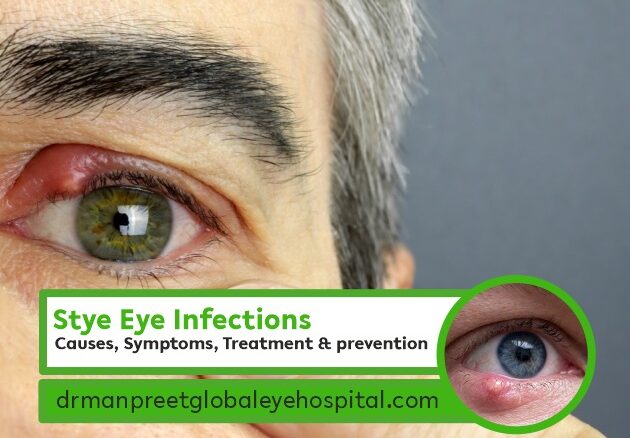Like other parts of the human body, the Eyes need to be kept clean and hygienic to prevent various types of eye infections from poor eye care. Maintaining deep eye hygiene regularly is essential to prevent diseases such as styes. This includes regularly cleaning the eyelids with a mild cleanser, avoiding touching or rubbing the eyes, and if you are using Contact lenses, ensuring they are properly stored and cleaned at the time of usage. Additionally, one has to avoid sharing personal eye care items, such as towels or makeup, to reduce the risk of spreading infections. If the eye infections persist beyond a few days, then it is advisable to consult an eye specialist. Proper examination & check-ups can help identify and treat potential issues early on.

A stye, also called a hordeolum, is an eyelid infection. It is caused by the bacteria Staphylococcus aureus, which can infect the eyelid’s hair follicles or oil glands. The disease causes a red, painful lump on the eyelid, which can resemble a pimple.
Common causes of styes include:
- Not properly & regularly cleaning eyelid areas
- Applying contaminated, low grade or expired makeup cosmetics
- using contact lenses with contaminated hands
- having a skin disease such as acne or rosacea

Treatment for a stye typically includes:
- Applying sterilized warm compressors like medical wipes or cotton pads to the affected area around your eyelids for 10-15 minutes several times a day.
- Maintain eye hygiene consistently.
- Avoiding the use of makeup and contact lenses until the stye has resolved.
- Using over-the-counter pain relievers to reduce pain and inflammation.

If the stye does not improve within a few days or becomes more painful, it is essential to see an eye doctor. Based on your infection severity, your eye doctor may drain the stye infection or prescribe an antibiotic to help clear the infection.
In addition to the treatment options mentioned above, here are some easy, homely tips to help prevent styes from forming or recurring. These include:
Keeping your hands clean: Avoid touching or rubbing your eyes, as this can transfer bacteria to the eyelid area.
Using a clean washcloth or cotton pad: When applying warm compresses, use a clean washcloth or cotton pad each time to avoid re-introducing bacteria to the affected area.
Wearing clean contact lenses: Make sure to properly clean and disinfect your contact lenses, and avoid wearing them while you have a stye.
Washing your face with mild medical-grade soaps: If you have a skin condition like acne or rosacea, keep your face clean and avoid using harsh or drying products.
IMPORTANT: Bear in mind that stye formation is a common and minor eye condition, but if it’s not treated correctly, it can lead to more severe problems. One of them is cellulitis – a bacterial infection that spreads to the deeper layers of the skin in the eyelid area. If the stye becomes very swollen and painful, if vision is affected, or if fever develops, it’s imperative to see a doctor as soon as possible.
Home remedial tips for a stye eye infection:

Use a warm compress: Place a warm, damp cloth over the affected eye for 10-15 minutes, several times a day. This can help to reduce pain and inflammation.
Keep the infected area clean: Gently wash the affected eye with sterilized water and mild soap. This can help to prevent further infection.
Avoid touching the stye with your hands. Likewise, avoid brushing or scratching the stye, as this can cause it to become more irritated and increase the risk of infection.
Try over-the-counter medications: Over-the-counter pain relievers, line Tab ibuprofen, would help relieve pain and associated inflammation & tenderness with a stye.
Avoid wearing contact lenses: If you wear contact lenses, avoid wearing them until the stye has completely healed.
Consult with a doctor if it persists: If your stye infection doesn’t improve after a couple of days of home treatment or if it becomes more painful, consult with a doctor.
Expert Inputs from
Dr Manpreet Singh – Chief Eye Surgeon – Global Eye Hospital Patiala, Punjab.

